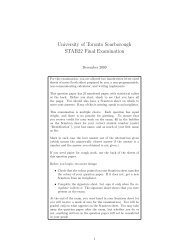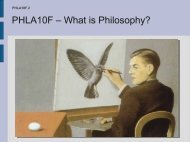Reading List - University of Toronto Scarborough
Reading List - University of Toronto Scarborough
Reading List - University of Toronto Scarborough
- No tags were found...
You also want an ePaper? Increase the reach of your titles
YUMPU automatically turns print PDFs into web optimized ePapers that Google loves.
Strategic interaction (game theory)* Gibbons, R. (1997), “An Introduction to Applicable Game Theory”, The Journal <strong>of</strong> EconomicPerspectives, 11(1): 127-149* Palacios-Huerta, I. (1996), “Pr<strong>of</strong>essionals Play Minimax”, Review <strong>of</strong> Economic Studies, 70(2): 395-415* Thaler, R.H. (1988), “Anomalies: The Winner’s Curse”, The Journal <strong>of</strong> Economic Perspectives, 2(1):191-202Axelrod, R. (1980), “Effective Choice in the Prisoner’s Dilemma”, Journal <strong>of</strong> Conflict Resolution,24(1): 3-25Bosch-Domènech, A., Montalvo, J.G., Nagel, R. and Satorra, A. (2002), “One, Two, (Three),Infinity, ... : Newspaper and Lab Beauty-Contest Experiments”, American EconomicReview, 92(5): 1687-1701Cho, I-K. and Kreps, D.M. (1987), “Signaling Games and Stable Equilibria”, The Quarterly Journal<strong>of</strong> Economics, 102(2): 179-221Dal Bó, P. (2005), “Cooperation under the Shadow <strong>of</strong> the Future: experimental evidence frominfinitely repeated games”, American Economic Review, 95(5): 1591-1604Fehr, E. and Gächter, S. (2000), “Fairness and Retaliation: The Economics <strong>of</strong> Reciprocity”, TheJournal <strong>of</strong> Economic PerspectivesKandori, M. (1992), “Social Norms and Community Enforcement”, The Review <strong>of</strong> EconomicStudies, 59(1): 63-80Kovash, K. and Levitt, S.D. (2009), “Pr<strong>of</strong>essionals Do Not Play Minimax: Evidence from MajorLeague Baseball and the National Football League”, MimeoKreps, D.M., Milgrom, P., Roberts, J. and Wilson, R. (1982), “Rational Cooperation in theFinitely Repeated Prisoners’ Dilemma”, Journal <strong>of</strong> Economic Theory, 27(2): 245-252Kreps, D.M. and Wilson, R. (1982), “Reputation and Imperfect Information”, Journal <strong>of</strong> EconomicTheory, 27(2)Myatt, D.P., Shin, H.S. and Wallace, C. (2002), “The Assessment: Games and Coordination”,Oxford Review <strong>of</strong> Economic Policy, 18(4): 397-417Myerson, R.B. (1999), “Nash Equilibrium and the History <strong>of</strong> Economic Theory”, Journal <strong>of</strong>Economic Literature, 37(3), 1067-1082Selten, R. (1975), “The Chain Store Paradox”, Theory and Decision, 9(2): 127-159Information* Akerl<strong>of</strong>, G.A. (1970), “The Market for “Lemons”: Quality Uncertainty and the MarketMechanism”, The Quarterly Journal <strong>of</strong> Economics, 84(3): 488-500* Farrell, J. and Rabin, M. (1996), “Cheap Talk”, The Journal <strong>of</strong> Economic Perspectives, 10(3): 103-118* Spence, M. (1973), “Job Market Signaling”, The Quarterly Journal <strong>of</strong> Economics, 87(3): 355-374Crawford, V.P. and Sobel, J. (1982), “Strategic Information Transmission”, Econometrica, 50(6):1431-1451Diamond, P.A. (1971), “A Model <strong>of</strong> Price Adjustment”, Journal <strong>of</strong> Economic Theory, 3(2): 156-168Lazear, E.P. (2000), “Performance Pay and Productivity”, American Economic Review, 90(5): 1346-1361Klein, B. and Leffler, K.B. (1982), “The Role <strong>of</strong> Market Forces in Assuring ContractualPerformance”, The Journal <strong>of</strong> Political Economy, 89(4): 615-641


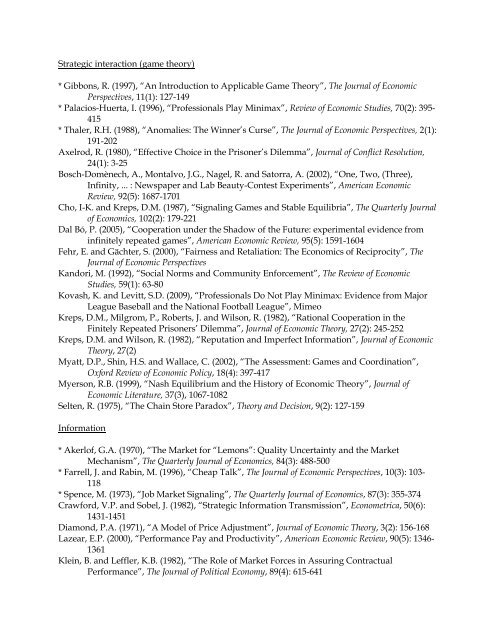
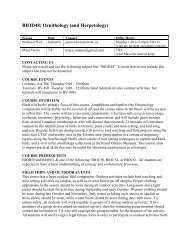
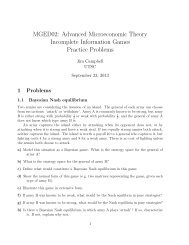


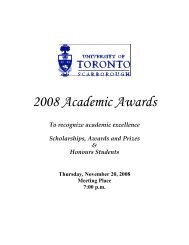
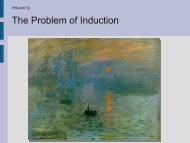
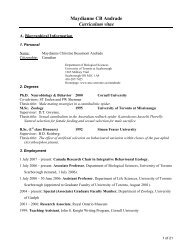
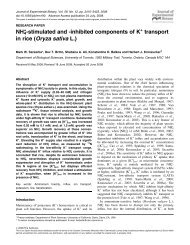
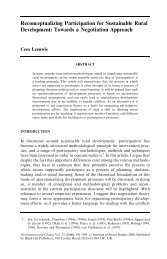
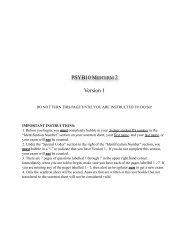
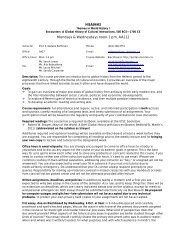
![[Enter course name - Syllabus] - University of Toronto Scarborough](https://img.yumpu.com/50068522/1/190x245/enter-course-name-syllabus-university-of-toronto-scarborough.jpg?quality=85)
